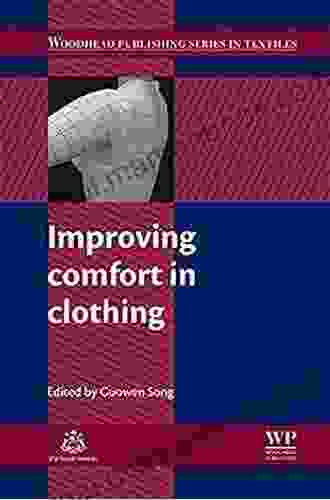Enhancing Clothing Comfort: Insights from Woodhead Publishing in Textiles 106

In the realm of textiles, comfort remains a paramount consideration that influences consumer satisfaction and product desirability. Woodhead Publishing's Textiles 106 delves into this multifaceted subject, providing a comprehensive roadmap for textile professionals, researchers, and fashion enthusiasts seeking to create garments that prioritize wearer well-being. This article will explore key insights from the publication, highlighting innovative approaches and practical strategies for improving comfort in clothing.
Understanding Comfort in Clothing
Comfort encompasses various aspects, including physical, physiological, and psychological experiences. Physical comfort pertains to the tactile properties of garments, such as softness, flexibility, and moisture management. Physiological comfort relates to the body's response to clothing, ensuring proper temperature regulation, breathability, and freedom of movement. Psychological comfort focuses on the wearer's emotional and cognitive perception of the clothing, influenced by aesthetics, fit, and personal preferences.
5 out of 5
| Language | : | English |
| File size | : | 7415 KB |
| Text-to-Speech | : | Enabled |
| Screen Reader | : | Supported |
| Enhanced typesetting | : | Enabled |
| Word Wise | : | Enabled |
| Print length | : | 496 pages |
Tactile Properties: Softness and Flexibility
The softness of clothing plays a crucial role in enhancing comfort. Soft fabrics envelop the body gently, reducing friction and providing a soothing sensation. Factors contributing to softness include fiber composition, yarn count, and fabric construction. Natural fibers like cotton and silk are inherently soft, while synthetic fibers can be modified to achieve similar properties. Yarn count refers to the thickness of the yarn used in fabric production; finer yarns result in softer fabrics. Knitted fabrics exhibit greater flexibility compared to woven fabrics, adapting effortlessly to body movements.
Moisture Management: Keeping You Dry and Comfortable
Moisture management is essential for preventing discomfort caused by sweat accumulation. Textiles with high moisture wicking capabilities draw sweat away from the skin, keeping the wearer dry and comfortable. Synthetic fibers, such as polyester, are particularly effective in wicking moisture, while natural fibers like cotton absorb moisture but are slower to dry. Fabrics with high breathability allow air circulation, promoting evaporation and further enhancing moisture management.
Temperature Regulation: Staying Warm or Cool
Clothing plays a vital role in temperature regulation, ensuring the wearer's comfort in various environments. In cold weather, garments with insulating properties trap body heat, preventing heat loss. Natural fibers like wool and fleece have excellent insulating capabilities due to their ability to trap air within their fibers. Synthetic insulation materials, such as PrimaLoft, provide similar performance with the added advantage of being lightweight and compressible. In warm weather, fabrics with high breathability and moisture wicking properties help dissipate body heat and keep the wearer cool.
Freedom of Movement: Unrestricted Comfort
Freedom of movement is essential for clothing to be comfortable. Restrictive garments can hinder movement, causing discomfort and fatigue. Stretch fabrics, featuring spandex or elastane fibers, allow for greater flexibility and range of motion. Knitted fabrics also offer inherent stretchiness due to their looped structure. Garments with articulated patterning, such as curved seams and gussets, further enhance freedom of movement by accommodating the body's natural contours.
Fit: The Perfect Balance
Proper fit is crucial for ensuring comfort. Ill-fitting garments can cause discomfort due to excessive tightness, looseness, or improper proportions. Tailoring and using adjustable fasteners can help achieve a personalized fit that minimizes discomfort. Body scanning technologies can provide precise measurements for custom-tailored garments, ensuring an optimal fit.
Psychological Comfort: Personal Style and Aesthetics
Psychological comfort encompasses the wearer's personal preferences, self-expression, and cultural influences. Clothing that aligns with the wearer's style and aesthetics contributes to a sense of well-being and confidence. Color, patterns, and textures play significant roles in creating visually appealing garments. Cultural and social factors also influence clothing choices, shaping perceptions of comfort and acceptability.
Sustainable Comfort: Eco-Friendly Fabrics and Practices
In today's environmentally conscious world, sustainable comfort practices are gaining recognition. Sustainable fabrics, produced with minimal environmental impact, contribute to comfort by reducing skin irritation and allergic reactions. Organic cotton, bamboo fibers, and recycled polyester are examples of eco-friendly fabrics. Ethical manufacturing practices that ensure fair labor and working conditions also contribute to the overall comfort experience.
Improving comfort in clothing requires a holistic approach that considers both physical and psychological factors. By understanding the principles of tactile properties, moisture management, temperature regulation, and freedom of movement, textile professionals can create garments that enhance wearer well-being. Psychological comfort, influenced by personal preferences and cultural influences, plays an equally important role. Sustainable comfort practices further contribute to a more ethical and environmentally conscious approach to clothing production. Woodhead Publishing's Textiles 106 serves as a valuable resource for those seeking to advance the science and practice of comfort in clothing, unlocking new frontiers of innovation and consumer satisfaction.
5 out of 5
| Language | : | English |
| File size | : | 7415 KB |
| Text-to-Speech | : | Enabled |
| Screen Reader | : | Supported |
| Enhanced typesetting | : | Enabled |
| Word Wise | : | Enabled |
| Print length | : | 496 pages |
Do you want to contribute by writing guest posts on this blog?
Please contact us and send us a resume of previous articles that you have written.
 Top Book
Top Book Novel
Novel Fiction
Fiction Nonfiction
Nonfiction Literature
Literature Paperback
Paperback Hardcover
Hardcover E-book
E-book Audiobook
Audiobook Bestseller
Bestseller Classic
Classic Mystery
Mystery Thriller
Thriller Romance
Romance Fantasy
Fantasy Science Fiction
Science Fiction Biography
Biography Memoir
Memoir Autobiography
Autobiography Poetry
Poetry Drama
Drama Historical Fiction
Historical Fiction Self-help
Self-help Young Adult
Young Adult Childrens Books
Childrens Books Graphic Novel
Graphic Novel Anthology
Anthology Series
Series Encyclopedia
Encyclopedia Reference
Reference Guidebook
Guidebook Textbook
Textbook Workbook
Workbook Journal
Journal Diary
Diary Manuscript
Manuscript Folio
Folio Pulp Fiction
Pulp Fiction Short Stories
Short Stories Fairy Tales
Fairy Tales Fables
Fables Mythology
Mythology Philosophy
Philosophy Religion
Religion Spirituality
Spirituality Essays
Essays Critique
Critique Commentary
Commentary Glossary
Glossary Bibliography
Bibliography Index
Index Table of Contents
Table of Contents Preface
Preface Introduction
Introduction Foreword
Foreword Afterword
Afterword Appendices
Appendices Annotations
Annotations Footnotes
Footnotes Epilogue
Epilogue Prologue
Prologue Aleksandra Mikic
Aleksandra Mikic Will Irwin
Will Irwin Bryan Goodwin
Bryan Goodwin Martin Aguilera
Martin Aguilera David Cohne
David Cohne Michelle Meagher
Michelle Meagher Katy Bowman
Katy Bowman Alex Haley
Alex Haley Alessandro Cuccuru
Alessandro Cuccuru Raymond S Edge
Raymond S Edge Larry Krohn
Larry Krohn Brett Allen
Brett Allen Clive Cussler
Clive Cussler Mckenzie Funk
Mckenzie Funk S Green
S Green Christopher Kimball
Christopher Kimball Alex Gadd
Alex Gadd Donna Michaels
Donna Michaels Alex Beyman
Alex Beyman Christine Platt
Christine Platt
Light bulbAdvertise smarter! Our strategic ad space ensures maximum exposure. Reserve your spot today!
 Tim ReedFollow ·2.2k
Tim ReedFollow ·2.2k H.G. WellsFollow ·3.2k
H.G. WellsFollow ·3.2k Brian BellFollow ·5.3k
Brian BellFollow ·5.3k Steven HayesFollow ·6.1k
Steven HayesFollow ·6.1k Jackson HayesFollow ·11.4k
Jackson HayesFollow ·11.4k Hamilton BellFollow ·10.2k
Hamilton BellFollow ·10.2k Herman MelvilleFollow ·2.8k
Herman MelvilleFollow ·2.8k Bo CoxFollow ·2.8k
Bo CoxFollow ·2.8k

 Alexandre Dumas
Alexandre DumasFugitive Telemetry: Unraveling the Secrets of the...
In the realm of...

 Caleb Carter
Caleb CarterBlack Clover Vol 25: Humans and Evil - A Journey into the...
Unveiling the Sinister Forces Black...

 Israel Bell
Israel BellHow to Make Offers So Good People Feel Stupid Saying No
In today's competitive business environment,...

 Simon Mitchell
Simon MitchellWrath of Hades: The Children of Atlantis
An Epic Tale of...

 Percy Bysshe Shelley
Percy Bysshe ShelleyStrengthen Your Immune System: Fight Off Infections,...
What is the...

 Clark Bell
Clark Bell10 Things I Wish Someone Had Told Me Earlier
As we navigate through life, we accumulate a...
5 out of 5
| Language | : | English |
| File size | : | 7415 KB |
| Text-to-Speech | : | Enabled |
| Screen Reader | : | Supported |
| Enhanced typesetting | : | Enabled |
| Word Wise | : | Enabled |
| Print length | : | 496 pages |










